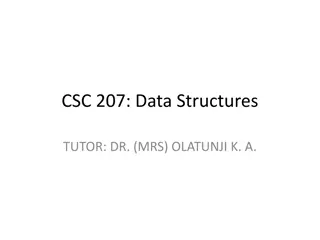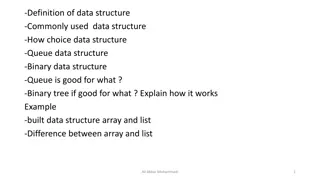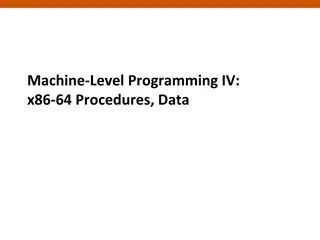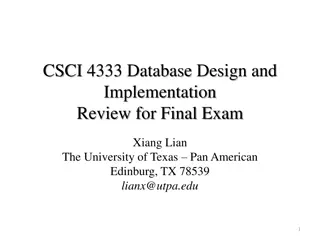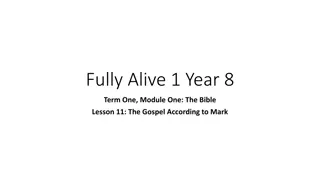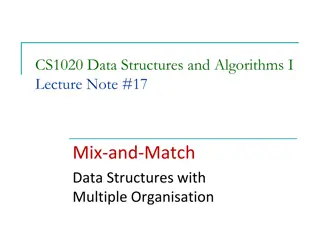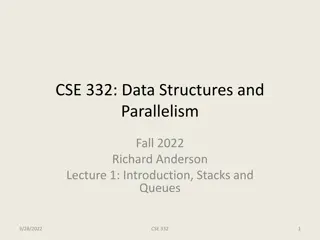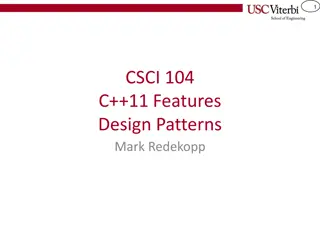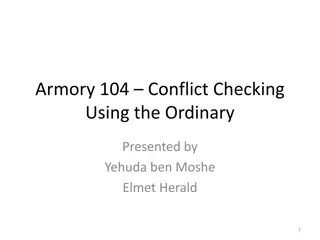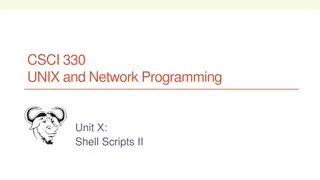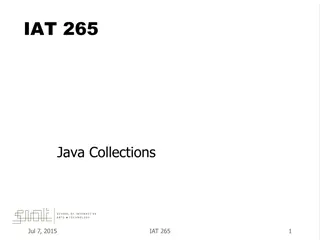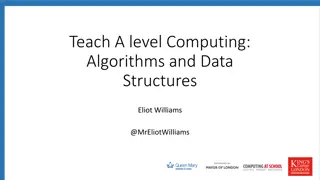Understanding Data Structures in CSCI 104 with Mark Redekopp
Explore the fundamentals of data structures in CSCI 104 with Professor Mark Redekopp. Delve into topics like arrays, linked lists, structs, classes, dynamic memory allocation, pointers, recursion, and more. Discover the importance of organizing data efficiently based on usage scenarios, such as frequent searches, additions, or removals. Learn how different data structures impact operations like insertion, searching, and accessing data with varying time and storage requirements.
Download Presentation

Please find below an Image/Link to download the presentation.
The content on the website is provided AS IS for your information and personal use only. It may not be sold, licensed, or shared on other websites without obtaining consent from the author. Download presentation by click this link. If you encounter any issues during the download, it is possible that the publisher has removed the file from their server.
E N D
Presentation Transcript
1 CSCI 104 Overview Mark Redekopp
2 Administrative Issues Preparation Basic if, while, for constructs Arrays, linked-lists Structs, classes Dynamic memory allocation and pointers Recursion Syllabus http://bits.usc.edu/cs104 Expectations I'll give you my best, you give me yours Attendance, participation, asking questions, academic integrity, take an interest Treat CS104 right! Let's make this fun
3 More Helpful Links Remedial modules http://ee.usc.edu/~redekopp/csmodules.html Class website http://bits.usc.edu/cs104
4 An Opening Example Consider a paper phonebook Stores names of people and their phone numbers What operations do we perform with this data You: Lookup/search Phone Company: Add, Remove How is the data stored and ordered and why? Sorted by name to make lookup faster How fast? That's for you to figure out What if it was sorted by phone number or just random? What is the worst case number of records you'd have to look at to find a particular persons phone number?
5 Opening Example (cont.) Would it ever be reasonable to have the phonebook in a random or unsorted order? What if the phonebook was for the residence of a town with only a few residents What if there was a phonebook for Mayflies (life expectancy of 1-24 hours) Might want to optimize for additions and removals Plus, a mayfly doesn't have fingers to dial their phones so why would they even be trying to search the phonebook Main Point: The best way to organize data depends on how it will be used. Frequent search Frequent addition/removals Addition/removal patterns (many at once or one at a time)
6 Why Data Structures Matter? Modern applications process vast amount of data Adding, removing, searching, and accessing are common operations Various data structures allow these operations to be completed with different time and storage requirements Data Structure Insert Search Get-Min Unsorted List O(1) O(n) O(n) Balanced Binary Search Tree O(lg n) O(lg n) O(lg n) Heap O(lg n) O(n) O(1) Recall O(n) indicates that the actual run-time is bounded by some expression a*n for some n > n0 (where a and n0 are constants)
7 Importance of Complexity 50 400 N N2 N*log2(N) 45 350 40 300 35 250 30 Run-time Run-time 25 200 20 150 15 100 10 50 5 0 0 0 5 10 15 20 25 N 30 35 40 45 50 0 2 4 6 8 10 N 12 14 16 18 20 O(n2) O(2n) N O(1) O(log2n) O(n) O(n*log2n) 2 1 1 2 2 4 4 20 1 4.3 20 86.4 400 1,048,576 200 1 7.6 200 1,528.8 40,000 1.60694E+60 2000 1 11.0 2000 21,931.6 4,000,000 #NUM!
8 Abstract Data Types Beginning programmers tend to focus on the code and less on the data and its organization More seasoned programmers focus first on What data they have How it should be organized How it will be accessed An abstract data type describes what data is stored and what operations are to be performed A data structure is a specific way of storing the data implementing the operations Example ADT: List Data: items of the same type in a particular order Operations: insert, remove, get item at location, set item at location, find Example data structures implementing a List: Linked list, array, etc.
9 Transition to Object-Oriented Object-oriented paradigm fits nicely with idea of ADTs Just as ADTs focus on data and operations performed on it so objects combine data + functions Objects (C++ Classes) allows for more legible, modular, maintainable code units Suppose you and a friend are doing an electronic dictionary app. Your friend codes the dictionary internals and you code the user-interface. You don't care how they implement it just that it supports the desired operations and is fast enough Abstraction: Provides a simplified interface allowing you to reason about the higher level logic and not the low level dictionary ops. Encapsulation: Shields inside from outside so that internals can be changed w/o affecting code using the object
10 Course Goals Learn about good programming practice with object- oriented design Learn good style and more advanced C++ topics such as templates, inheritance, polymorphism, etc. Learn basic and advanced techniques for implementing data structures and analyzing their efficiency May require strong fundamentals including mathematical analysis This is why we couple CS 104 and CS 170
11 STREAMS REVIEW
12 Kinds of Streams I/O streams Keyboard (cin) and monitor (cout) File streams Contents of file are the stream of data #include <fstream> and #include <iostream> ifstream and ofstream objects String streams #include <sstream> and #include iostream sstream objects Streams support appropriate << or >> operators as well as .fail(), .getline(), .get(), .eof() member functions
13 C++ Stream Input cin, ifstreams, and stringstreams can be used to accept data from the user int x; cout << "Enter a number: "; cin >> x; What if the user does not enter a valid number? Check cin.fail( ) to see if the read worked What if the user enters multiple values? >> reads up until the first piece of whitespace cin.getline() can read a max number of chars until it hits a delimeter but only works for C-strings (character arrays) cin.getline(buf, 80) // reads everything through a '\n' // stopping after 80 chars if no '\n' cin.getline(buf, 80, ';') // reads everything through a ';' // stopping after 80 chars if no ';' The <string> header defines a getline(...) method that will read an entire line (including whitespace): string x; getline(cin,x,';'); // reads everything through a ';'
14 When Does It Fail For files & string streams the stream doesn't fail until you read PAST the EOF char buf[40]; ifstream inf(argv[1]); getp File text T h e e n d . \n EOF getp inf >> buf; File text T h e e n d . \n EOF EOF BAD FAIL buf T h e \0 0 0 0 getp inf >> buf; File text T h e e n d . \n EOF EOF BAD FAIL buf e n d . \0 0 0 0 inf >> buf; getp File text T h e e n d . \n EOF EOF BAD FAIL buf e n d . \0 1 0 1
15 Which Option? data.txt #include<iostream> #include<fstream> using namespace std; int main() { vector<int> nums; ifstream ifile("data.txt"); int x; while( 1 ){ ifile >> x; if(ifile.fail()) break; nums.push_back(x); } ... } #include<iostream> #include<fstream> using namespace std; int main() { vector<int> nums; ifstream ifile("data.txt"); int x; while( !ifile.fail() ){ ifile >> x; nums.push_back(x); } ... } 7 8 EOF nums _ _ _ _ Need to check for failure after you extract but before you store/use int x; while( ifile >> x ){ nums.push_back(x); } ... A stream returns itself after extraction A stream can be used as a bool (returns true if it hasn't failed)
16 Choices Where is my data? Keyboard (use _____) String File (use ______) (use _____) Do I know how many items to read? Yes, n items Use _____ No, arbitrary Use _____
17 Choices What type of data? Text Integers/ Doubles Is it delimited? Yes No Yes
18 Choices Where is my data? Keyboard String File (use iostream [cin]) (use stringstream) (use ifstream) Do I know how many items to read? No, arbitrary Yes, n items Use for(i=0;i<n;i++) Use while(cin >> temp) or while(getline(cin,temp))
19 Choices What type of data? Ints/Doubles (Use >> b/c it converts text to the given type) Text (getline or >>) getline ALWAYS returns text Is it delimited? Yes at special chars (';' or ',') Use getline with 3rd input parameter (delimeter parameter) Yes at newlines Use getline() No, stop on any whitespace use >>
20 getline() and stringstreams int num_lines = 0; int total_words = 0; Imagine a file has a certain format where you know related data is on a single line of text but aren't sure how many data items will be on that line Can we use >>? No it doesn't differentiate between different whitespace (i.e. a ' ' and a '\n' look the same to >> and it will skip over them) We can use getline() to get the whole line, then a stringstream with >> to parse out the pieces ifstream myfile(argv[1]); string myline; while( getline(myfile, myline) ){ stringstream ss(myline); string word; while( ss >> word ) { total_words++; } num_lines++; } double avg = (double) total_words / num_lines; cout << "Avg. words per line: "; cout << avg << endl; The fox jumped over the log. The bear ate some honey. The CS student solved a hard problem.
21 Using Delimeters Text file: Imagine a file has a certain format where you know related data is on a single line of text but aren't sure how many data items will be on that line Can we use >>? No it doesn't differentiate between different whitespace (i.e. a ' ' and a '\n' look the same to >> and it will skip over them) We can use getline() to get the whole line, then a stringstream with >> to parse out the pieces garbage stuff (words I care about) junk vector<string> mywords; ifstream myfile(argv[1]); string myline; getline(myfile, myline, '('); // gets "garbage stuff " // and throws away '(' getline(myfile, myline, ')' ); // gets "words I care about" // and throws away ')'` stringstream ss(myline); string word; while( ss >> word ) { mywords.push_back(word); } 0 1 2 3 "words" "I" "care" "about" mywords
22 Choosing an I/O Strategy Is my data delimited by particular characters? Yes, stop on newlines: Use getline() Yes, stop on other character: User getline() with optional 3rd character No, Use >> to skip all whitespaces and convert to a different data type (int, double, etc.) If "yes" above, do I need to break data into smaller pieces (vs. just wanting one large string) Yes, create a stringstream and extract using >> No, just keep the string returned by getline() Is the number of items you need to read known as a constant or a variable read in earlier? Yes, Use a loop and extract (>>) values placing them in array or vector No, Loop while extraction doesn't fail placing them in vector Remember: getline() always gives text/string. To convert to other types it is easiest to use >>
23 You are responsible for this on your own since its covered in CS103 C++ LIBRARY REVIEW (END LECTURE 1 SLIDES)
24 C++ Library String I/O Streams Vector
25 C Strings In C, strings are: Character arrays (char mystring[80]) Terminated with a NULL character Passed by reference/pointer (char *) to functions Require care when making copies Shallow (only copying the pointer) vs. Deep (copying the entire array of characters) Processed using C String library (<cstring>)
26 String Function/Library (cstring) In C, we have to pass the C-String as an argument for the function to operate on it int strlen(char *dest) int strcmp(char *str1, char *str2); Return 0 if equal, >0 if first non-equal char in str1 is alphanumerically larger, <0 otherwise char *strcpy(char *dest, char *src); strncpy(char *dest, char *src, int n); Maximum of n characters copied char *strcat(char *dest, char *src); strncat(char *dest, char *src, int n); Maximum of n characters concatenated plus a NULL char *strchr(char *str, char c); Finds first occurrence of character c in str returning a pointer to that character or NULL if the character is not found #include <cstring> using namespace std; int main() { char temp_buf[5]; char str[] = "Too much"; strcpy(temp_buf, str); strncpy(temp_buf, str, 4); temp_buf[4] = '\0' return 0; }
27 C++ Strings So you don't like remembering all these details? You can do it! Don't give up. C++ provides a 'string' class that abstracts all those worrisome details and encapsulates all the code to actually handle: Memory allocation and sizing Deep copy etc.
28 String Examples #include <iostream> #include <string> using namespace std; Must: #include <string> using namespace std; Initializations / Assignment Use initialization constructor Use = operator Can reassign and all memory allocation will be handled Redefines operators: + (concatenate / append) += (append) ==, !=, >, <, <=, >= (comparison) [] (access individual character) http://www.cplusplus.com/reference/string/string/ int main(int argc, char *argv[]) { int len; string s1("CS is "); string s2 = "fun"; s2 = "really fun"; cout << s1 << " is " << s2 << endl; s2 = s2 + !!! ; cout << s2 << endl; string s3 = s1; if (s1 == s3){ cout << s1 << " same as " << s3; cout << endl; } cout << First letter is << s1[0]; cout << endl; } Output: CS is really fun really fun!!! CS is same as CS is First letter is C
29 More String Examples #include <iostream> #include <string> using namespace std; Size/Length of string Get C String (char *) equiv. Find a substring Searches for occurrence of a substring Returns either the index where the substring starts or string::npos std::npos is a constant meaning just beyond the end of the string it s a way of saying Not found Get a substring Pass it the start character and the number of characters to copy Returns a new string Others: replace, rfind, etc. int main(int argc, char *argv[]) { string s1( abc def ); cout << "Len of s1: " << s1.size() << endl; char my_c_str[80]; strcpy(my_c_str, s1.c_str() ); cout << my_c_str << endl; if(s1.find( bc d ) != string::npos) cout << Found bc_d starting at pos= : cout << s1.find( bc_d ) << endl; found = s1.find( def ); if( found != string::npos){ string s2 = s1.substr(found,3) cout << s2 << endl; } } Len of s1: 7 abc def The string is: abc def Found bc_d starting at pos=1 def Output: http://www.cplusplus.com/reference/string/string/
30 C++ Strings Why do we need the string class? C style strings are character arrays (char[ ]) See previous discussion of why we don't like arrays C style strings need a null terminator ('\0') abcd is actually a char[5] Why? Stuff like this won't compile: char my_string[7] = abc + def ; How can strings help? Easier to use, less error prone Has overloaded operators like +, =, [], etc. Lots of built-in functionality (e.g. find, substr, etc.)
31 C++ Streams What is a stream ? A sequence of characters or bytes (of potentially infinite length) used for input and output. C++ has four major libraries we will use for streams: <iostream> <fstream> <sstream> <iomanip> Stream models some input and/or output device fstream => a file on the hard drive; cin => keyboard and cout => monitor C++ has two operators that are used with streams Insertion Operator << Extraction Operator >>
32 C++ I/O Manipulators The <iomanip> header file has a number of manipulators to modify how I/O behaves Alignment: internal, left, right, setw, setfill Numeric: setprecision, fixed, scientific, showpoint Other: endl, ends, flush, etc. http://www.cplusplus.com/reference/iostream/manipulators/ Use these inline with your cout/cerr/cin statements double pi = 3.1415; cout << setprecision(2) << fixed << pi << endl;
33 Understanding Extraction User enters value 512 at 1stprompt, enters 123 at 2nd prompt int x=0; X = cin = 0 cout << Enter X: ; X = cin = 0 5 1 2 \n cin >> x; X = cin = 512 \n cin.fail() is false Y = cin = 0 \n int y = 0; 0 Y = cin = \n 1 2 3 \n cout << Enter Y: ; cin >> y; Y = cin = 123 \n cin.fail() is false
34 Understanding Extraction User enters value 23 99 at 1st prompt, 2nd prompt skipped int x=0; X = cin = 0 cout << Enter X: ; X = cin = 0 2 3 9 9 \n cin >> x; X = cin = 23 9 9 \n cin.fail() is false int y = 0; Y = cin = 0 9 9 \n cout << Enter Y: ; 0 Y = cin = 9 9 \n cin >> y; Y = cin = 99 \n cin.fail() is false
35 Understanding Extraction User enters value 23abc at 1st prompt, 2nd prompt fails int x=0; X = cin = 0 cout << Enter X: ; X = cin = 3 a 0 2 b c \n cin >> x; X = cin = a b c \n 23 cin.fail() is false Y = cin = 0 a b c \n int y = 0; 0 Y = cin = a b c \n cout << Enter Y: ; cin >> y; Y = cin = xxx a b c \n cin.fail() is true
36 Understanding Extraction User enters value 23 99 at 1st prompt, everything read as string string x; X = cin = cout << Enter X: ; getline(cin,x); X = cin = 2 3 9 9 \n EOF X = cin = 23 99 cin.fail() is false NOTE: \n character is discarded!
37 Understanding cin Things to remember When a read operation on cin goes wrong, the fail flag is set If the fail flag is set, all reads will automatically fail right away This flag stays set until you clear it using the cin.clear() function cin.good() returns true if ALL flags are false When you're done with a read operation on cin, you should wipe the input stream Use the cin.ignore(...) method to wipe any remaining data off of cin Example: cin.ignore(1000,'\n'); cin.clear(); EOF BAD FAIL istream (cin) T/F T/F T/F
38 Understanding Extraction User enters value 23abc at 1st prompt, 2nd prompt fails Y = cin = int y = 0; 0 a b c \n EOF cout << Enter Y: ; 0 Y = cin = a b c \n EOF cin >> y; Y = cin = xxx a b c \n EOF cin.fail() is true EOF BAD FAIL cin.ignore(100, '\n'); cin = EOF 0 0 1 // doing a cin >> here will // still have the fail bit set EOF BAD FAIL cin = EOF 0 0 0 cin.clear(); // now safe to do cin >>
39 C++ File I/O Use <fstream> library for reading/writing files Use the open( ) method to get access to a file ofstream out; //ofstream is for writing, ifstream is for reading out.open( my_filename.txt ) //must be a C style string! Write to a file exactly as you would the console! out << This line gets written to the file << endl; Make sure to close the file when you're done out.close(); Use fail( ) to check if the file opened properly out.open( my_filename.txt ) if(out.fail()) cerr << Could not open the output file! ;
40 Validating User Input Reading user input is easy, validating it is hard What are some ways to track whether or not the user has entered valid input? Use the fail( ) function on cin and re-prompt the user for input Use a stringstream for data conversions and check the fail( ) method on the stringstream Read data in as a string and use the cctype header to validate each character (http://www.cplusplus.com/reference/clibrary/cctype/) for(int i=0; i < str.size(); i++) if( ! isdigit(str[i]) ) cerr << str is not a number! << endl
41 C++ String Stream If streams are just sequences of characters, aren't strings themselves like a stream? The <sstream> library lets you treat C++ string objects like they were streams Why would you want to treat a string as a stream? Buffer up output for later display Parse out the pieces of a string Data type conversions This is where you'll use stringstream the most! Very useful in conjunction with string's getline(...)
42 C++ String Stream Convert numbers into strings (i.e. 12345 => "12345") #include<sstream> using namespace std; int main() { stringstream ss; int number = 12345; ss << number; string strNumber; ss >> strNumber; return 0; } sstream_test1.cpp
43 C++ String Stream Convert string into numbers [same as atoi()] #include<sstream> using namespace std; int main() { stringstream ss; string numStr = 12345 ; ss << numStr; int num; ss >> num; return 0; } sstream_test2.cpp
44 C++ String Stream Beware of re-using the same stringstream object for multiple conversions. It can be weird. Make sure you clear it out between uses and re-init with an empty string Or just make a new stringstream each time stringstream ss; //do something with ss ss.clear(); ss.str(""); // now you can reuse ss // or just declare another stream stringstream ss2;
45 C++ Arrays What are arrays good for? Keeping collections of many pieces of the same data type (e.g. I want to store 100 integers) int n[100]; Each value is called out explicitly by its index Indexes start at 0: Read an array value: cout << 5th value = << n[4] << endl; Write an array value n[2] = 255;
46 C++ Arrays Unfortunately C++ arrays can be tricky... Arrays need a contiguous block of memory Arrays are difficult/costly to resize Arrays don't know their own size You must pass the size around with the array Arrays don't do bounds checking Potential for buffer overflow security holes e.g. Twilight Hack: http://wiibrew.org/wiki/Twilight_Hack Arrays are not automatically initialized Arrays can't be directly returned from a function You have to decay them to pointers
47 C++ Vectors Why do we need the vector class? Arrays are a fixed size. Resizing is a pain. Arrays don't know their size (no bounds checking) This compiles: int stuff[5]; cout << stuff[-1] << and << stuff[100]; How can vectors help? Automatic resizing to fit data Sanity checking on bounds They do everything arrays can do, but more safely Sometimes at the cost of performance See http://www.cplusplus.com/reference/stl/
48 Vector Class Container class (what it contains is up to you via a template) Mimics an array where we have an indexed set of homogenous objects Resizes automatically #include <iostream> #include <vector> using namespace std; int main() { vector<int> my_vec(5); // init. size of 5 for(unsigned int i=0; i < 5; i++){ my_vec[i] = i+50; } my_vec.push_back(10); my_vec.push_back(8); my_vec[0] = 30; unsigned int i; for(i=0; i < my_vec.size(); i++){ cout << my_vec[i] << ; } cout << endl; int x = my_vec.back(); // gets back val. x += my_vec.front(); // gets front val. // x is now 38; cout << x is << x << endl; my_vec.pop_back(); my_vec.erase(my_vec.begin() + 2); my_vec.insert(my_vec.begin() + 1, 43); return 0; } 1 2 0 1 2 3 4 1 2 3 4 my_vec 50 51 52 53 54 0 1 2 3 4 5 6 3 my_vec 30 51 52 53 54 10 8 0 1 2 3 4 5 my_vec 30 51 52 53 54 10 4 0 1 2 3 4 5 my_vec 30 43 51 53 54 10
49 Vector Class constructor Can pass an initial number of items or leave blank operator[ ] Allows array style indexed access (e.g. myvec[1] + myvec[2]) push_back(T new_val) Adds a copy of new_val to the end of the array allocating more memory if necessary size(), empty() Size returns the current number of items stored as an unsigned int Empty returns True if no items in the vector pop_back() Removes the item at the back of the vector (does not return it) front(), back() Return item at front or back erase(iterator) Removes item at specified index (use begin() + index) insert(iterator, T new_val) Adds new_val at specified index (use begin() + index) #include <iostream> #include <vector> using namespace std; int main() { vector<int> my_vec(5); // 5= init. size for(unsigned int i=0; i < 5; i++){ my_vec[i] = i+50; } my_vec.push_back(10); my_vec.push_back(8); my_vec[0] = 30; for(int i=0; i < my_vec.size(); i++){ cout << my_vec[i] << ; } cout << endl; int x = my_vec.back(); // gets back val. x += my_vec.front(); // gets front val. // x is now 38; cout << x is << x << endl; my_vec.pop_back(); my_vec.erase(my_vec.begin() + 2); my_vec.insert(my_vec.begin() + 1, 43); return 0; }
50 Vector Suggestions #include <iostream> #include <vector> If you don t provide an initial size to the vector, you must add items using push_back() When iterating over the items with a for loop, used an unsigned int When adding an item, a copy will be made to add to the vector [] or at() return a reference to an element, not a copy of the element Usually pass-by-reference if an argument to avoid the wasted time of making a copy using namespace std; int main() { vector<int> my_vec; for(int i=0; i < 5; i++){ // my_vec[i] = i+50; // doesn t work my_vec.push_back(i+50); } for(unsigned int i=0; i < my_vec.size(); i++) { cout << my_vec[i] << " "; } cout << endl; my_vec[1] = 5; my_vec.at(2) = 6; do_something(myvec); return 0; } void do_something(vector<int> &v) { // process v; }


